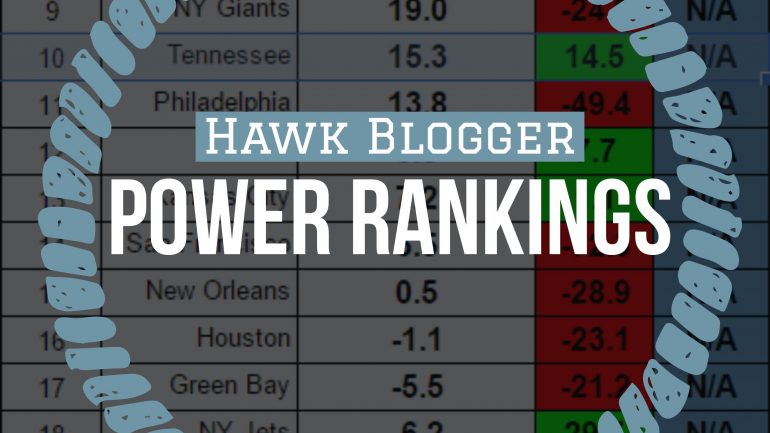The rankings seem a little more sane this week. New England is the class of the league. San Francisco has done nothing but dominate on both sides of the ball. Kansas City lost their first game, but still boast plenty of big numbers and a strong strength of schedule (SOS). The Vikings are an interesting story, as there has been more discussion about their dysfunction than about the reasonably strong start they have had.
Minnesota has a 100.0 team passer rating, is averaging 5.4 yards per rush, and outscoring opponents by an average of 22.4 to 14.6, all while playing a middle-of-the-pack schedule. That defense is legit, and the offense is strong enough to make them a tough opponent.
To be honest, I’m shocked to see Seattle so high. Yes, they are my favorite team and they are 4-1, but their defense is pretty darn mediocre. Much of the Seahawks position is thanks to leading the league in passer rating, and having the third best passer rating differential (+34) in the NFL behind the Patriots (+53) and 49ers (+37.1).
One team you don’t see anywhere near the top ten is the Saints. They are 20th. I was so shocked that I went back and double-checked all my numbers. It’s true. The Saints have allowed more points than they have scored, allowed a higher passer rating than they have registered, and allowed more yards per carry than they have averaged. Somehow, someway, they are 4-1. It defies statistical logic.
The Rams are way down there with them as their team passer rating is now 83.0, and they are allowing 92.9 to opponents.

Rankings Visualization
This view shows tiers of strength that develop over the course of the season.

RANKINGS EXPLAINED
Power rankings are always debatable. I don’t buy into the gut feel methods most places use to determine their rankings, so I developed a formula a few years back that attempts to take at least some of the subjectivity out of the discussion. My approach was simple, I measured offensive and defensive efficiency based on the Yards Per Carry (YPC) and Yards Per Attempt (YPA), as well as points scored and points allowed. The formula to calculate “Team Strength” was as follows:
(YPC (offense) + YPA (offense) + Avg Pts/Game Scored) – (YPC (defense) + YPA (defense)+ Avg Pts/Game Allowed)
The formula has proven to be a pretty accurate predictor of success (roughly 70% of the teams ranked in the Top 10 by week 3 make the playoffs), but I am always looking for ways to improve it. I read a great article on ColdHardFootballFacts.com. There was one gem in there about predicting championship teams. The article mentioned passer rating differential as the “mother of all stats.” A full 69 of 72 champions have ranked in the Top 10 in this statistic. It is a stat after my own heart, as I believe offensive and defensive efficiency is the key measurable outside of point differential. Turnovers would factor in there as well, but I am not convinced a team has as much control over that. My power rankings use YPA and YPC differentials. I went ahead and replaced the YPA with offensive and defensive passer rating, to give me this:
(YPC (offense) + Passer Rating (offense) + Avg Pts/Game Scored) – (OPP YPC (defense) + OPP Passer Rating (defense)+ OPP Avg Pts/Game) As of September 23, 2014, I have added a strength of schedule component to the rankings as well. As of November 22, 2016, I have increased the weighting of the run game and point differential. Yards per carry will be multiplied by 10 to make it more evenly weighted with the passer rating. It is still roughly half as important, but will have a greater impact. Point differential will be multiplied by two as it still should be among the most important aspects of measuring teams.
